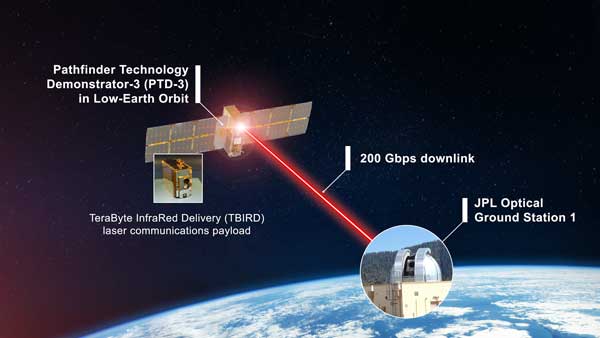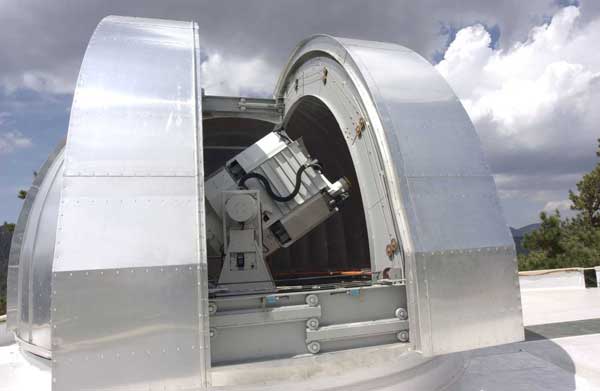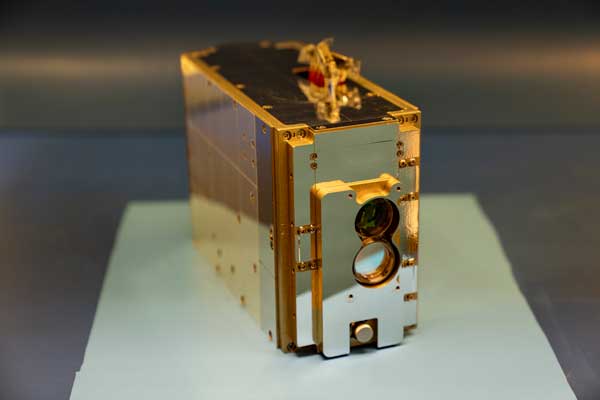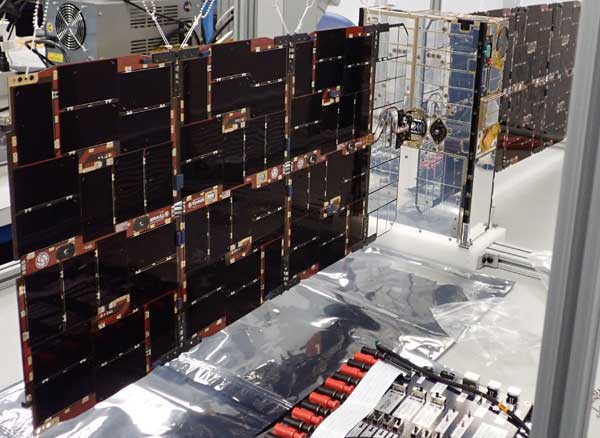By Kendall Murphy
NASA’s Goddard Space Flight Center
GREENBELT, Md. — NASA’s Pathfinder Technology Demonstrator 3 (PTD-3) mission, carrying the TeraByte InfraRed Delivery (TBIRD) system, will debut on May 25 as part of SpaceX’s Transporter-5 rideshare launch. TBIRD will showcase the high-data-rate capabilities of laser communications from a CubeSat in low-Earth orbit. At 200 gigabits per second (Gbps), TBIRD will downlink data at the highest optical rate ever achieved by NASA.
NASA primarily uses radio frequency to communicate with spacecraft, but with sights set on human exploration of the Moon and Mars and the development of enhanced scientific instruments, NASA needs more efficient communications systems to transmit significant amounts of data. With more data, researchers can make profound discoveries. Laser communications substantially increases data transport capabilities, offering higher data rates and more information packed into a single transmission.
“TBIRD is a game changer and will be very important for future human exploration and science missions.” said Andreas Doulaveris, TBIRD’s mission systems engineer at NASA’s Goddard Space Flight Center in Greenbelt, Maryland.
With a single seven-minute pass at 200 Gbps, TBIRD will send back terabytes of data and give NASA more insight into the capabilities of laser communications. The addition of laser communications to spacecraft is similar to switching from dial-up to high-speed internet.
“As future science instruments and imaging systems incorporate the latest technology advancements, they’ll return very large volumes of data on a daily basis,” said Jason Mitchell, Director of the Advanced Communications and Navigation Technology division within NASA’s Space Communications and Navigation (SCaN) program. “These missions will need the downlink capabilities that laser communications can provide.”

Illustration of TBIRD downlinking data over lasers links to Optical Ground Station 1 in California. (Not drawn to scale) (Credits: NASA/Dave Ryan)
The TBIRD system, funded by SCaN and built by the Massachusetts Institute of Technology Lincoln Laboratory in Lexington, is about the size of a tissue box and is integrated into PTD-3, a CubeSat that is the size of two stacked cereal boxes.
The Small Spacecraft Technology program at NASA’s Ames Research Center in California’s Silicon Valley manages the PTD mission series. The PTD series leverages a common commercial spacecraft to provide a robust platform for effective testing of technologies with minimal redesign in between launches.
“Small spacecraft continue to prove themselves vital building blocks for larger, more complicated missions,” said Roger Hunter, program manager for Small Spacecraft Technology at Ames. “We are pushing the envelope by increasing the pace of subsystem technology demonstrations through the innovations of our industry partners.”
Historically, most new spacecraft missions have required custom spacecraft designs based on the requirements of their payloads. This step is as costly and complex as redesigning a car every time a person needs to travel. Each PTD mission uses the same spacecraft bus and avionics platform designs with the goal of increasing efficiency and reducing the amount of time required for mission planning and design.
Terran Orbital of Irvine, California, provides the spacecraft, integrates the payload, and operates PTD missions. This approach allows the PTD series to rapidly and affordably demonstrate new subsystem technologies for increasing small spacecraft capabilities.
In addition to being on a standardized commercial spacecraft, TBIRD was also built from existing commercial, telecommunications hardware products that were modified for the extreme environment of space. Leveraging existing components increases efficiency and creates cost savings.

In the course of the mission, PTD-3 will demonstrate highly stable body pointing, meaning the spacecraft can be precisely directed toward the ground station to facilitate TBIRD’s downlink demonstration. TBIRD’s streamlined design does not contain any moving mechanisms, so the spacecraft’s pointing ability enables the laser communications telescope’s connection from space to ground. TBIRD’s ground station is in Table Mountain, California, and is managed by NASA’s Jet Proplusion Laboratory in Southern California.
During TBIRD’s six-month operations, NASA and its partners will gather as much information as possible about laser communications functionality on small satellites. PTD-3 will launch as soon as May 25, 2022, from Cape Canaveral Space Force Station in Florida on SpaceX’s Transporter-5 rideshare mission, which will use a Falcon 9 rocket to launch multiple CubeSats.
Together, PTD-3 and TBIRD have the capacity to help NASA make giant leaps in the advancement of space technology for laser communications and the overall utility of small spacecraft to support exploration and science goals.
A second, separate technology demonstration supported by NASA’s Small Spacecraft Technology program will also be aboard the Transporter-5 launch: the CubeSat Proximity Operations Demonstration, which will demonstrate rendezvous, proximity operations, and docking using two 3-unit CubeSats.


